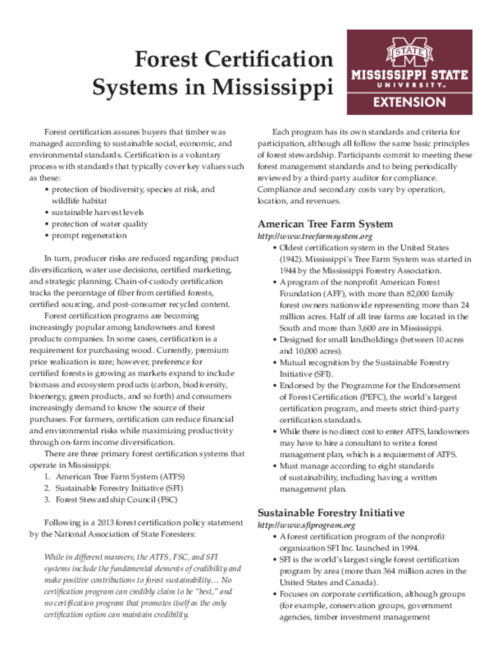P3518
Forest Certification Systems in Mississippi
Forest certification assures buyers that timber was managed according to sustainable social, economic, and environmental standards. Certification is a voluntary process with standards that typically cover key values such as these:
- protection of biodiversity, species at risk, and wildlife habitat
- sustainable harvest levels
- protection of water quality
- prompt regeneration
In turn, producer risks are reduced regarding product diversification, water use decisions, certified marketing, and strategic planning. Chain-of-custody certification tracks the percentage of fiber from certified forests, certified sourcing, and post-consumer recycled content.
Forest certification programs are becoming increasingly popular among landowners and forest products companies. In some cases, certification is a requirement for purchasing wood. Currently, premium price realization is rare; however, preference for certified forests is growing as markets expand to include biomass and ecosystem products (carbon, biodiversity, bioenergy, green products, and so forth) and consumers increasingly demand to know the source of their purchases. For farmers, certification can reduce financial and environmental risks while maximizing productivity through on-farm income diversification.
There are three primary forest certification systems that operate in Mississippi:
- American Tree Farm System (ATFS)
- Sustainable Forestry Initiative (SFI)
- Forest Stewardship Council (FSC)
Following is a 2013 forest certification policy statement by the National Association of State Foresters:
While in different manners, the ATFS, FSC, and SFI systems include the fundamental elements of credibility and make positive contributions to forest sustainability… No certification program can credibly claim to be “best,” and no certification program that promotes itself as the only certification option can maintain credibility.
Each program has its own standards and criteria for participation, although all follow the same basic principles of forest stewardship. Participants commit to meeting these forest management standards and to being periodically reviewed by a third-party auditor for compliance. Compliance and secondary costs vary by operation, location, and revenues.
American Tree Farm System
- Oldest certification system in the United States (1942). Mississippi’s Tree Farm System was started in 1944 by the Mississippi Forestry Association.
- A program of the nonprofit American Forest Foundation (AFF), with more than 82,000 family forest owners nationwide representing more than 24 million acres. Half of all tree farms are located in the South and more than 3,600 are in Mississippi.
- Designed for small landholdings (between 10 acres and 10,000 acres).
- Mutual recognition by the Sustainable Forestry Initiative (SFI).
- Endorsed by the Programme for the Endorsement of Forest Certification (PEFC), the world’s largest certification program, and meets strict third-party certification standards.
- While there is no direct cost to enter ATFS, landowners may have to hire a consultant to write a forest management plan, which is a requirement of ATFS.
- Must manage according to eight standards of sustainability, including having a written management plan.
Sustainable Forestry Initiative
- A forest certification program of the nonprofit organization SFI Inc. launched in 1994.
- SFI is the world’s largest single forest certification program by area (more than 364 million acres in the United States and Canada).
- Focuses on corporate certification, although groups (for example, conservation groups, government agencies, timber investment management organizations, and real estate investment trusts) are also eligible.
- One of the fastest-growing organizations for chain-of-custody certifications (allowing participants to use SFI trademarks and labels).
- SFI has 13 principles developed by professional foresters, conservationists, scientists, and others.
- PEFC recognizes SFI standards.
- SFI certifies timber companies such as Weyerhaeuser and Plum Creek.
- Like ATFS, SFI allows for uneven-aged management.
Forest Stewardship Council
- Created in 1993 in Bonn, Germany, FSC is an international member organization that originally focused on mitigating tropical deforestation; it now includes temperate and boreal forests.
- Rules and procedures ensure FSC is transparent, independent, and participatory across countries. Almost 500 million acres are certified to FSC’s principles and criteria in 80 countries. More than 35,000 FSC chain-of-custody certificates are active in 107 countries.
- Certifies forestland of 2,470 acres or less in addition to larger properties.
- FSC has six program areas: forests, chain of custody, social policy, monitoring and evaluation, quality assurance, and ecosystem services.
- FSC has 10 principles and associated criteria. FSC is the strictest of the three certification systems.
- Approved by the Leadership in Energy and Environmental Design (LEED) rating system for “green building.”
Additional Reading
Gordon, J. S. Information Sheet 1966, Chain of Custody in Forest Certification Systems. Mississippi State University Extension Service.
Gordon, J. S., and L. Garnett. Publication 2743, Forest Stewardship Principles for Mississippi Landowners. Mississippi State University Extension Service.
Publication 3518 (POD-07-23)
Reviewed by Brady Self, PhD, Associate Extension Professor, Forestry. Revised by John Auel, PhD, former Assistant Extension Professor, Forestry.
The Mississippi State University Extension Service is working to ensure all web content is accessible to all users. If you need assistance accessing any of our content, please email the webteam or call 662-325-2262.
